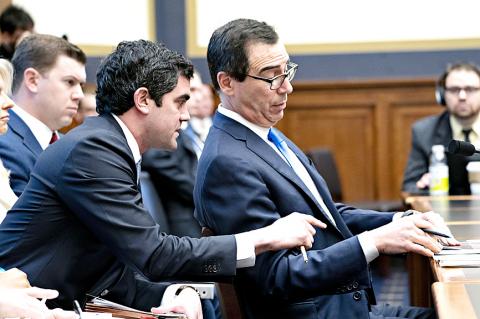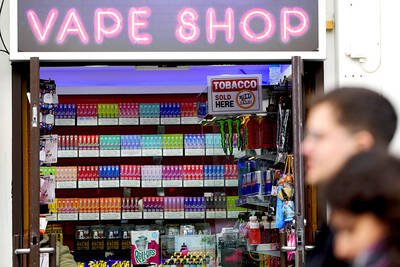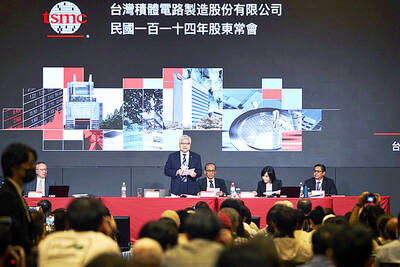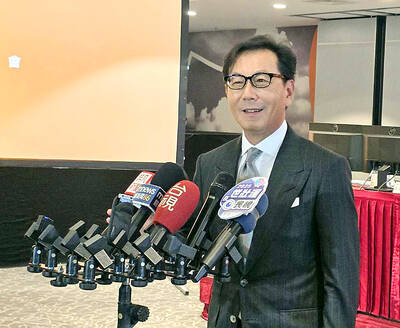The World Bank on Thursday said that its board adopted a new plan to aid China with US$1 billion to US$1.5 billion in low-interest loans annually through June 2025, despite the objections of US Secretary of the Treasury Steven Mnuchin and several US lawmakers.
The US Treasury’s representative on the board had objected on to the plan on Wednesday, Mnuchin told a US House of Representatives Financial Services Committee hearing, adding that he wants the World Bank to “graduate” China from its concessional loan programs for low and middle-income countries.
The five-year lending strategy plan was published on Thursday afternoon after the World Bank’s board “expressed broad support” for the multilateral development lender’s engagement in China’s structural and environmental reforms.

Photo: Bloomberg
The World Bank said its lending would decline over the “country partnership framework” plan, in line with reforms agreed on under a US$13 billion capital increase agreed to last year.
The World Bank loaned China US$1.3 billion in the fiscal 2019 year ended June 30, down from about US$2.4 billion in fiscal 2017. The new plan calls for lending to “gradually decline” from the previous five-year average of US$1.8 billion.
“Lending levels may fluctuate up and down from year to year due to normal pipeline management based on project readiness,” the World Bank said in its plan.
Beijing had requested continued financing from the World Bank’s International Bank for Reconstruction and Development division “as platforms for reform, institution building and knowledge transfer,” it said.
Mnuchin has argued that China is too wealthy for such international aid when it is lending hundreds of billions of dollars of its own to poor countries through its Belt and Road Infrastructure drive.
US lawmakers are also increasingly expressing concerns that US taxpayer funds loaned through the World Bank to China will enable human rights abuses and unfair economic competition with the US.
In US Senate floor remarks on Thursday, Senate Finance Committee Chairman Charles Grassley cited alleged human rights abuses in Xinjiang associated with detention camps for Muslim Uighurs in criticizing the World Bank lending plan.
“The World Bank, using American tax dollars, should not be lending to wealthy countries that violate the human rights of their citizens and attempt to dominate weaker countries either militarily or economically,” Grassley said.
US Representative Anthony Gonzalez, who has introduced legislation to curb World Bank funding to China, said: “For me, even a dollar is too much for our taxpayers to be contributing to China.”
Although the US hold an effective veto power over major board decisions such as capital increases and leadership appointments, the latest China lending plan did not require a formal vote.
Mnuchin told lawmakers he expected the World Bank’s lending to China to fall below US$1 billion during the current fiscal year, with more repayment funds flowing back to the lender from China than loan funds going out.
The World Bank said the lending to China in the five-year plan would be aimed at advancing market and fiscal reforms to encourage private-sector development; promoting greener growth by reducing pollution and reducing carbon emissions; and increasing Chinese citizens’ access to health and social services.

CAUTIOUS RECOVERY: While the manufacturing sector returned to growth amid the US-China trade truce, firms remain wary as uncertainty clouds the outlook, the CIER said The local manufacturing sector returned to expansion last month, as the official purchasing managers’ index (PMI) rose 2.1 points to 51.0, driven by a temporary easing in US-China trade tensions, the Chung-Hua Institution for Economic Research (CIER, 中華經濟研究院) said yesterday. The PMI gauges the health of the manufacturing industry, with readings above 50 indicating expansion and those below 50 signaling contraction. “Firms are not as pessimistic as they were in April, but they remain far from optimistic,” CIER president Lien Hsien-ming (連賢明) said at a news conference. The full impact of US tariff decisions is unlikely to become clear until later this month

Popular vape brands such as Geek Bar might get more expensive in the US — if you can find them at all. Shipments of vapes from China to the US ground to a near halt last month from a year ago, official data showed, hit by US President Donald Trump’s tariffs and a crackdown on unauthorized e-cigarettes in the world’s biggest market for smoking alternatives. That includes Geek Bar, a brand of flavored vapes that is not authorized to sell in the US, but which had been widely available due to porous import controls. One retailer, who asked not to be named, because

CHIP DUTIES: TSMC said it voiced its concerns to Washington about tariffs, telling the US commerce department that it wants ‘fair treatment’ to protect its competitiveness Taiwan Semiconductor Manufacturing Co (TSMC, 台積電) yesterday reiterated robust business prospects for this year as strong artificial intelligence (AI) chip demand from Nvidia Corp and other customers would absorb the impacts of US tariffs. “The impact of tariffs would be indirect, as the custom tax is the importers’ responsibility, not the exporters,” TSMC chairman and chief executive officer C.C. Wei (魏哲家) said at the chipmaker’s annual shareholders’ meeting in Hsinchu City. TSMC’s business could be affected if people become reluctant to buy electronics due to inflated prices, Wei said. In addition, the chipmaker has voiced its concern to the US Department of Commerce

STILL LOADED: Last year’s richest person, Quanta Computer Inc chairman Barry Lam, dropped to second place despite an 8 percent increase in his wealth to US$12.6 billion Staff writer, with CNA Daniel Tsai (蔡明忠) and Richard Tsai (蔡明興), the brothers who run Fubon Group (富邦集團), topped the Forbes list of Taiwan’s 50 richest people this year, released on Wednesday in New York. The magazine said that a stronger New Taiwan dollar pushed the combined wealth of Taiwan’s 50 richest people up 13 percent, from US$174 billion to US$197 billion, with 36 of the people on the list seeing their wealth increase. That came as Taiwan’s economy grew 4.6 percent last year, its fastest pace in three years, driven by the strong performance of the semiconductor industry, the magazine said. The Tsai